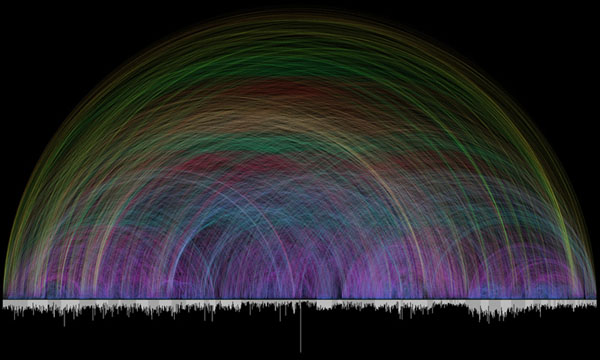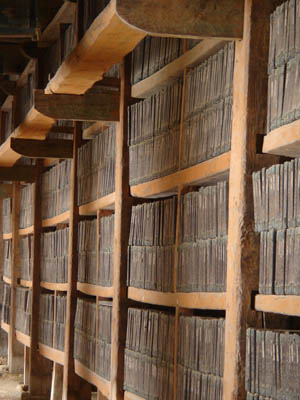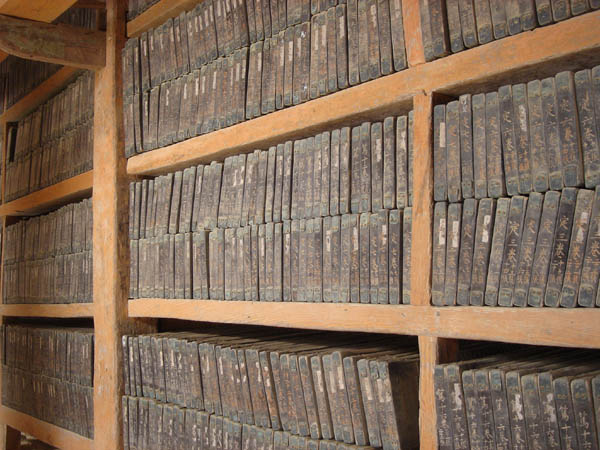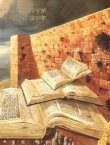The image below shows every cross-references in the Bible. Definitely more the eye candy variety of information visualization, but I thought it was pretty.

Chris Harrison, the creator, explains: “Different colors are used for various arc lengths, creating a rainbow like effect. The bar graph running along the bottom shows every chapter in the Bible and their respective lengths (in verses). Books alternate in color between white and light gray.”
(Via Information Aesthetics)
Category Archives: bible
the bible on dvd: another weird embodiment of the book on screen
The bible has long been a driver of innovation in book design, and this latest is no exception: an ad I saw today on TV for the complete King James Bible on DVD. Not a film, mind you, but an interactive edition of the old and new testaments built around a graphical rendering of an old bible open on a lectern that the reader, uh viewer, uh… reader controls. Each page is synched up to a full-text narration in the “crystal clear, mellow baritone” of Emmy-winning Bible reader Stephen Johnston, along with assorted other actors and dramatic sound effects bringing the stories to life.
There’s the ad to the right (though when I saw it on BET the family was black). You can also download an actual demo (Real format) here. It’s interesting to see the interactivity of the DVD used to mimic a physical book — even the package is designed to suggest the embossed leather of an old bible, opening up to the incongruous sight of a pair of shiny CDs. More than a few analogies could be drawn to the British Library’s manuscript-mimicking “Turning the Pages,” which Sally profiled here last week, though here the pages replace each other with much less fidelity to the real.
There’s no shortage of movie dramatizations aimed at making the bible more accessible to churchgoers and families in the age of TV and the net. What the makers of this DVD seem to have figured out is how to combine the couch potato ritual of television with the much older practice of group scriptural reading. Whether or not you’d prefer to read the bible in this way, with remote control in hand, you can’t deny that it keeps the focus on the text.
Last week, Jesse argued that it’s not technology that’s causing a decline in book-reading, but rather a lack of new technologies that make books readable in the new communications environment. He was talking about books online, but the DVD bible serves just as well to illustrate how a text (a text that, to say the least, is still in high demand) might be repurposed in the context of newer media.
Another great driver of innovation in DVDs: pornography. No other genre has made more creative use of the multiple camera views options that can be offered simulataneously on a single film in the DVD format (I don’t have to spell out what for). They say that necessity is the mother of invention, and what greater necessities than sex and god? You won’t necessarily find the world’s most elegant design, but it’s good to keep track of these uniquely high-demand areas as they are consistently ahead of the curve.
the future of the book: korea, 13th century
The database:


Nestled in the Gaya mountain range in southern Korea, the Haeinsa monastery houses the Tripitaka Koreana, the largest, most complete set of Buddhist scriptures in existence — over 80,000 wooden tablets (enough to print all of Buddhism’s sacred texts) kept in open-air storage for the past six centuries. The tablets were carved between 1237 and 1251 in anticipation of the impending Mongol invasion, both as a spiritual effort to ward off the attack, and as an insurance policy. They replaced an earlier set of blocks that had been destroyed in the last Mongol incursion in 1231.

From Korea’s national heritage site description of the tablets:
The printing blocks are some 70cm wide 24cm long and 2.8cm thick on the average. Each block has 23 lines of text, each with 14 characters, on each side. Each block thus has a total of 644 characters on both sides. Some 30 men carved the total 52,382,960 characters in the clean and simple style of Song Chinese master calligrapher Ou-yang Hsun, which was widely favored by the aristocratic elites of Goryeo. The carvers worked with incredible dedication and precision without making a single error. They are said to have knelt down and bowed after carving each character. The script is so uniform from beginning to end that the woodblocks look like the work of one person.


I stayed at the Haeinsa temple last Friday night on a sleeping mat in bare room with a heated floor, alongside a number of noisy Koreans (including the rather sardonic temple webmaster — Haiensa is a Unesco World Heritage site and so keeps a high profile). At three in the morning, at the call to the day’s first service, I tramped around the snowy courtyards under crisp, chill stars and watched as the monks pounded a massive barrel-shaped drum hanging inside a pagoda. This was for the benefit of those praying inside the temple (where it sounds like distant thunder). Shivering to the side, I continued to watch as they rang a bell the size of a Volkswagen with a polished log swung on ropes like a wrecking ball. Next to it, another monk ripped out a loud, clattering drum roll inside the wooden ribs of a dragon-like fish, also suspended from the pagoda’s roof. It was freezing cold with a biting wind — not pleasant to be outside, and at such an hour. But the stars were absolutely vivid. I’m no good at picking out constellations, but Orion was poised unmistakeably above the mountains as though stalking an elk on the other side of the ridge.
It’s a magical, somewhat harsh place, Haiensa. The Changgyeonggak, the two storage halls that house the Tripitaka, were built ingeniously to preserve the tablets by blocking wind, facilitating ventilation and distributing moisture. You see the monks busying themselves with devotions and chores, practicing an ancient way of life founded upon those tablets. The whole monastery a kind of computer, the monks running routines to and from the database. The mountains, Orion, the drum all part of the program. It seemed almost more hi-tech than cutting edge Seoul.
More on that later.
is nothing sacred?
A few weeks ago, Ben posted about The Bible Society of Australia‘s new “transl8tion” of the Bible into SMS–a shorthand system used primarily for sending text messages through mobile phones. Interesting to note that an organization like the Australian Bible Society, which believes the text of the Bible to be the very word of God, does not seem have a problem with the fact that the SMS version changes the voice of god from that of a wizened poet to that of a text-messaging teenager. Here’s an example:
4 god so luvd da world
I’m all for reading on cellphones and other portable devices, and I understand using a shorthand language for keying in messages, but why does the published book need to look like an electronic stenographer’s notepad? I realize that the form of the electronic “page” is changing the way we write, but I’ll be more than a little disappointed if this is the direction we are going–toward a cutesy-looking shorthand that compromises the integrity of the text for the sake of expediency. The aesthetic beauty of words is no small thing. Great writers understand this. They know how to choose words that weave visual and aural subtext into their work. Consider, for a moment, whether those subtleties translate into SMS. Imagine a text messagable Gettysburg address: 4 scor & 7 yr.z ago… Or a shrunk-to-fit Dickens: it wz d best of tImz, it wz d worst of tImz.
Are you with me when I say that they jst dun hav d powR of d orignL txt.
digital torah
 Varda Books, in collaboration with The Jewish Publication Society, has over the last few years been publishing a series of electronic editions of sacred Jewish texts, commentaries, historical studies, and critical resources, all leveraging the dynamic analytic capabilities of digital media. Popular on Varda’s online retail site, ebookshuk, are book “bundles” – collections of sacred texts and critical commentaries that enable nimble and complex intertextual analysis, or, as described for the “JPS Digital Torah Library,” serve as the “cornerstone of one’s personal, open-standards, inter-linked, cross-file-searchable, digital Jewish library.” Other bundles include “Judaic Scholar Digital Reference Library I” and “The Rabbinic Bookshelf.”
Varda Books, in collaboration with The Jewish Publication Society, has over the last few years been publishing a series of electronic editions of sacred Jewish texts, commentaries, historical studies, and critical resources, all leveraging the dynamic analytic capabilities of digital media. Popular on Varda’s online retail site, ebookshuk, are book “bundles” – collections of sacred texts and critical commentaries that enable nimble and complex intertextual analysis, or, as described for the “JPS Digital Torah Library,” serve as the “cornerstone of one’s personal, open-standards, inter-linked, cross-file-searchable, digital Jewish library.” Other bundles include “Judaic Scholar Digital Reference Library I” and “The Rabbinic Bookshelf.”
Jewish scriptural study and the Talmud have often been cited as among the earliest great hypertext traditions. Layered interpretations and non-linear modes of reading have long been central to this tradition, which continues to evolve into digital space.
